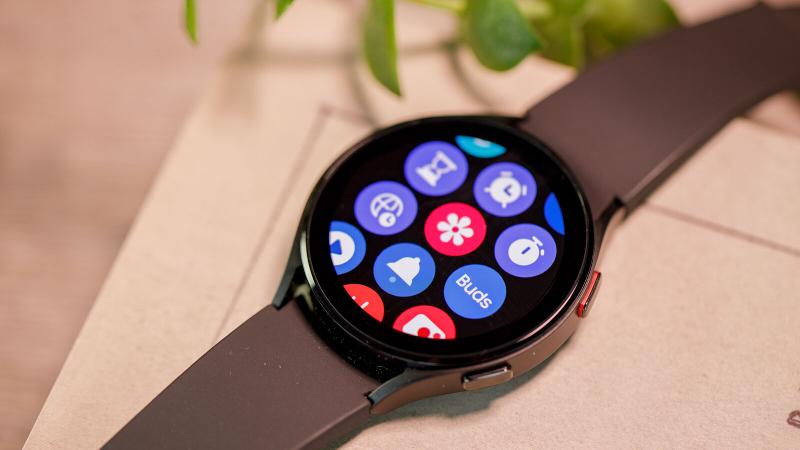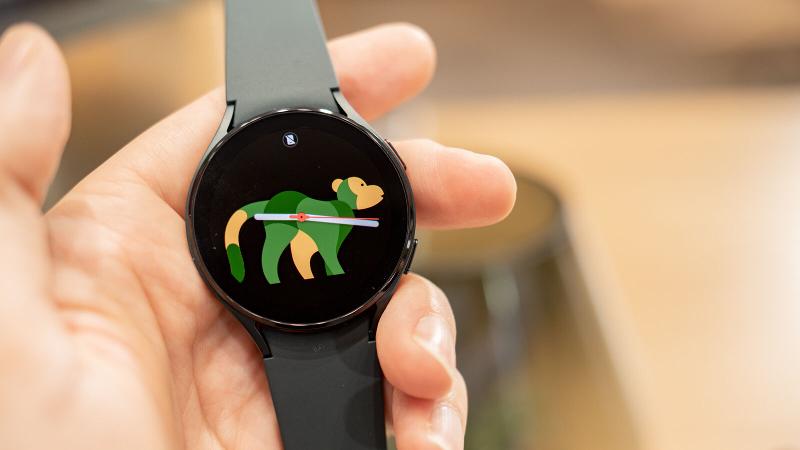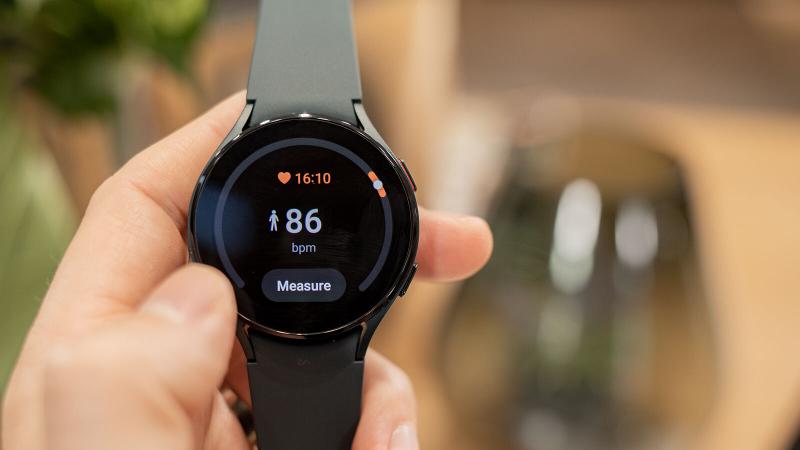Expert's Rating
Pros
- Better software than ever
- Smooth performance
- Simple design
- Body composition tracking
Cons
- Some features limited to Samsung phones
- Not Qi-compatible
Our Verdict
The Galaxy Watch 4 is the best smartwatch for any Android phone user right now, with cutting edge hardware and brand-new software developed together with Google.
Best Prices Today: Samsung Galaxy Watch 4
Samsung’s Galaxy Watch 4 is a big deal, and not only for Samsung. It marks a reinvention of the company’s smartwatch line, but also the introduction of new software co-engineered with Google – making this also the debut of the overhauled Wear OS 3.
The good news is that Samsung has mostly nailed the experience. From a hardware perspective the Galaxy Watch 4 is hard to fault, while the new software makes this basically the best smartwatch you can buy that doesn’t have an Apple logo on it – for now at least.
The only real downside is that Samsung is busy erecting a walled garden to rival its Californian rival, and as a result the Galaxy Watch 4 is at its best when paired with a Samsung phone. Other Android owners will at least still find plenty to like, even if a couple features are missing, but iPhone users are left in the cold – this won’t work at all.
Design and build
- Minimalist aesthetic
- Available in two sizes
- IP68 & 5ATM water-resistance
- Compatible with standard watch straps
The Galaxy Watch 4 boasts a slick, sparse design that looks good, but clearly isn’t intended to draw too much attention to itself.

It’s available in two sizes – 40mm and 44mm – and a range of colours: black and silver are available for either size, while pink gold is reserved for the smaller model and dark green for the larger version.
I’ve been testing the larger model, and it does feel a little chunky. The 40mm model may fare better, but I doubt it – they’re the same thickness at 9.8mm, so if anything the smaller variant may feel proportionately heftier.
In any case, the circular watch body itself is encased in what Samsung calls ‘Armor Aluminium’ – the same metal it uses for the frames of the new Galaxy Z Fold 3 and Z Flip 3 phones. The default strap is a rubberised number, but of course Samsung sells various options, and either size of Watch 4 can also be fitted with bog standard 20mm watch straps – though they won’t sit quite as flush against the body as Samsung’s official curved straps.

On the watch itself you’ll only find two buttons along the right-hand side, with all other controls limited to the touch screen – look at the more expensive Watch 4 Classic if you want a physical rotating bezel and more traditional aesthetic.
Of course, the Watch 4 is also waterproof, with an IP68 rating for dust and water protection, along with a 5ATM rating – meaning it’s good to withstand pressure as deep as 50m. Throw in a Gorilla Glass DX+ coating on the display and an MIL-STD-810G toughness rating and you should be able to trust this to hold up to most rough treatment.
The long and short of is that the Galaxy Watch 4 is attractive but restrained. If you want a watch that either stands out or emulates classic watch designs, this won’t be it, but if you prefer your smartwatch to get out of the way and let you focus on what it actually does, this should certainly appeal.
Display and audio
- Bright, vibrant AMOLED display
- Always-on display options
- Integrated mic and speaker
With such a minimalist design elsewhere, extra prominence is given to the Watch 4’s display.
Samsung has opted to use an AMOLED panel here, and it’s bright and vibrant even in direct sunlight, with really punchy colours that make the most of array of watch faces included – with over 20 installed out of the box, most fairly customisable, and plenty more available to download.

The smaller 40mm model includes a 1.2in, 396×396 panel, with the larger 44mm model jumping to 1.4in, 450×450. These are the exact same displays found in the two sizes of the Watch 4 Classic, for what it’s worth.
There is still a fairly thick black bezel around the edges of the display – one advantage of the Classic, where this is mostly blocked by the physical bezel – and I’d like to see Samsung shrink this space next time around, though it isn’t really too bothersome.
One perk of opting for OLED tech is that it supports an always-on display option, which will keep the time and some other information on-screen 24/7 – though at a fairly serious hit to battery life, so I’d only recommend it if you’re consistent about charging daily.

Fortunately, the raise-to-wake and tap-to-wake options both work well, so I never felt like I was missing too much by switching off the AOD. Additional screen settings like enhanced touch sensitivity for gloved use, or a water lock to disable touch input while swimming and showering, show Samsung has thought carefully about the other headaches a touch-sensitive smartwatch can introduce.
As for audio, an integrated microphone and speaker mean that you can take calls directly on the watch or use it for virtual assistant control. Bluetooth audio is also available to patch through directly to headphones.
Software and features
- ‘Wear OS Powered by Samsung’
- Extensive app and watch face ecosystem
- Bixby built-in – Google Assistant added later on 24 May 2022
The Galaxy Watch 4 is – sort of – the debut of Google’s third generation of Wear OS.
Wear OS 3 is a collaboration between Google and Samsung, which had previously developed its own TizenOS to use on its smartwatches. Strictly speaking, Wear OS 3 doesn’t debut until 2022, and instead this watch officially runs ‘Wear OS powered by Samsung’. Practically speaking, this is clearly a first glimpse at Google’s overhaul, albeit with Samsung’s spin on top.
That means that you’ll get Samsung’s own new One UI Watch interface, which means that navigating the Galaxy Watch 4 feels closer to the company’s Galaxy phones than anything from Google, while priority is given to the likes of Samsung Pay and Bixby over the likes of Google Pay and Google Assistant – Google’s payment system is supported, but not via hardware shortcut.

Out of the box the Watch 4 includes a pretty standard array of smartwatch features: a host of fitness and health tracking (more on that later), plus calendar, contacts, alarms, timers, weather, and a voice recorder.
Notifications are fully supported too, along with a welcome array of options to reply to incoming messages, from a few short automated responses to a squiggly, gesture-based keyboard to type out longer replies.
Since launch, Samsung has added gesture controls to accept/decline calls, cancel alarms, or open a set app. Google Assistant support has also made its way to the Watch 4 line, nine months after release. These are not only welcome additions but a good indicator that Samsung intends to keep the Watch 4 updated with software improvements.

If you want to add a little extra, the biggest software improvement here is the option to install new watch apps from the Google Play Store. That opens up a host of apps, from watch face collections to YouTube Music and Spotify, utilities like Google Keep or AccuWeather, and third-party fitness and health tools from the likes of Adidas and Calm.
In addition to apps, you’re more likely to navigate the watch via the Tiles, which are laid out to the right of the home screen. These are essentially quick-access widgets for each app, and are the easiest way to use the phone’s fitness features and more. They’re simple to tweak, select, and re-order, so it’s quick to customise the Watch 4 to best suit how you use it.
On the Watch 4 Classic, you’d use the rotating bezel to quickly scroll through these Tiles, while here you can do the same thing by spinning your fingertip round the edge of display. It takes a little getting used to, but haptic feedback as you spin makes this a surprisingly satisfying way to navigate the OS.

As mentioned above, the Watch 4 will work with any Android phone, though will miss out on a couple of specific fitness features. On iOS it’s a different story though, as the Watch 4 won’t work at all – so iPhone owners who don’t want an Apple Watch will have to look elsewhere.
Fitness and tracking
- 80+ fitness activities
- Heart rate, SpO2, sleep & stress tracking
- New body composition sensor
The Watch 4 features fitness and health tracking that could only be described as ‘comprehensive’.
Thanks to an array of sensors you can keep track of not only your heart rate, but also blood oxygen levels, irregular heartbeats, sleep quality, stress, and one major new one: body composition.

Much like many smart scales, the Galaxy Watch 4 uses bioelectrical impedance to assess the proportion of fat, muscle, and water that makes up your body. Testing takes 30 seconds or so, and involves touching the buttons with two of your fingers for the duration.
The results weren’t perfectly consistent with my Withings Body Cardio, which I suspect is the more accurate of the two. But for a quick guideline this is handy, and it’s a genuinely unique feature compare to other smartwatches. It should also be welcome to anyone who wants to track their body composition without obsessing over their actual weight, which is hard to avoid when using a scale.
Other tracking is easy and reliable, with heart rate, stress, and sleep all able to run automatically, and the remainder manual. Sleep tracking is especially impressive, with results closely matching those from the under-mattress Withings Sleep Analyzer.

Data is shared with the optional Samsung Health app on your phone. The only exceptions are the ECG and blood pressure readings, which for some reason are instead shared with the distinct Samsung Health Monitor app – which is only available on Samsung phones. Without a Samsung phone with the app installed you can’t take an ECG or blood pressure reading at all, so if you’re on any other Android device then bear that in mind.
Outside of those health features, there is of course step and fitness tracking. 13 trackable workouts are installed by default, but Samsung Health features more than 80 for you to choose from if your favourite isn’t included out of the box.
Automatic workout tracking is there to help to, and has impressed me with its reliability, kicking in even on relatively short walks – and including in the tracking the stats from the first few minutes or so before it actually activates the workout mode.
Specs and performance
- New Exynos W920 chipset
- Smooth performance
- 16GB storage
Specs aren’t the first thing people think about with a smartwatch, but they’re worth considering.
Samsung has upgraded the chip inside the Galaxy Watch 4, and the new Exynos W920 is notable because it moves to a smaller and more efficient 5nm process. In theory that means increased power, but also improved power efficiency.

Setting battery life aside for the moment, there’s clearly plenty of power here. The Galaxy Watch 4 is consistently smooth and fluid to use, and across a few weeks with the watch I never felt it lag, stutter, or struggle with anything I asked it to do.
The chipset is paired with 1.5GB of RAM and an improved 16GB storage – which doesn’t sound like much, but for a watch should be plenty in terms of both installed apps and downloaded music for offline playback.
Bluetooth 5.0 is supported, along with Wi-Fi (though not Wi-Fi 6), along with NFC for payments. LTE is also available, though you have the choice of paying extra for it, with Bluetooth+Wi-Fi only models also available.
Battery and charging
- Up to two-day battery
- Wireless charging – but not Qi
Samsung quotes ‘up to 40 hours’ of battery for the Watch 4, and that’s about right – though there’s a huge range of variability depending on how you use the watch.
On the default settings, including sleep tracking, I found the Watch 4 would last me just about two days, so I didn’t need to stress about charging it every day. Of course, battery will degrade over time, but it seems likely that this will always be able to safely last at least the 24 hours for a full day including sleep tracking.
Activating the always-on display will drain that battery significantly, and essentially turns it into a single-day device. Factors like how frequent you set the heart rate monitoring, how much you use the Watch 4 for exercise monitoring, and how much you use it for music playback or replying to messages, will of course affect battery life too.

I’ve been testing the larger 44mm model, which unsurprisingly comes with a larger battery too. The 40mm version may not last quite as long – but then it does have a smaller display to compensate for the smaller battery, so in reality I’d expect it all to balance out.
It takes roughly an hour and a half to reach a full charge on Samsung’s supplied puck charger, though you’ll get enough juice to last the day from just half an hour or so. That’s not bad, but I’d still like to see faster speeds – on a busy day you may struggle to find the time to leave your watch charging when you don’t need it, unless you’re willing to forgo sleep tracking.
It also supports wireless charging, and can be topped up through the reverse wireless charging on certain Samsung Galaxy phones – though this is achingly slow. It technically doesn’t use the Qi standard, so won’t work with standard wireless chargers. Some people report better luck with this, but I tried on two charging pads with no success.
Price and availability
The Galaxy Watch 4 is available worldwide now, and between the two sizes and LTE options is essentially available in four versions:
- 40mm Bluetooth: £249/€269/$249
- 40mm 4G: £289/€319/$299
- 44mm Bluetooth: £269/€299/$279
- 44mm 4G: £309/€349/$329
It’s available in a few set colour/strap combinations from retailers like Amazon, but if you buy directly from Samsung you can use the Bespoke Studio to pick the exact combination that you want.
If you prefer the look of the Galaxy Watch 4 Classic, this is also available, but will cost £100/€100/$100 more despite packing essentially the same functionality – so you’re paying a lot more for the classic aesthetic and rotating bezel.

Check out our guide to the best smartwatches on the market right now to find out how the Watch 4 compares to the competition, or our pick of the best Watch 4 deals if you know that’s what you want.
Verdict
The Galaxy Watch 4 continues Samsung’s impressive smartwatch track record, but the partnership with Google seems to have elevated both parties.
At least until Wear OS 3 launches in full in 2022, this iteration is probably the best smartwatch software outside of an Apple Watch, and the chipset improvements and body composition tracking ensure that the hardware is specced to match.
It’s a shame that a couple of the tracking metrics are limited to Samsung phone owners, which might be enough to make other Android users hesitant – and iPhone owners can’t use this at all. But if you’re already inside the Samsung ecosystem there’s simply no better smartwatch for you right now.
Specs
Samsung Galaxy Watch 4: Specs
- 1.2in 396×396 (40mm) or 1.4in 450×450 (44mm) circular AMOLED always-on display
- Gorilla Glass DX+
- 1.18GHz dual-core Exynos W920 5nm processor
- 1.5GB RAM
- 16GB ROM
- Wear OS Powered by Samsung
- One UI Watch
- Bluetooth 5.0
- NFC
- GPS
- Wi-Fi
- 4G LTE (optional)
- Microphone
- Speaker
- Knox security
- Optical heart rate sensor (PPG)
- Electrical heart sensor (ECG)
- Bioelectrical impedance analysis sensor (BIA)
- Blood oxygen tracking
- AFib irregular heartbeat detection
- Sleep tracking
- Snore detection
- Body composition analysis
- Guided workouts
- Bixby Voice
- Gesture controls
- Stainless steel casing
- 5ATM swim-proof
- IP68-certified dust/water resistance
- MIL-STD-810G tested
- Wireless charging
- 247mAh (40mm) or 361mAh battery (44mm)
- 40.4 x 39.3 x 9.8mm (40mm) or 44.4 x 43.3 x 9.8mm (44mm)
- 26g (40mm) or 30g (44mm)
- Colours: Black, silver, pink gold, green
- Compatible with Android 6.0 or higher (devices require more than 1.5GB RAM)



